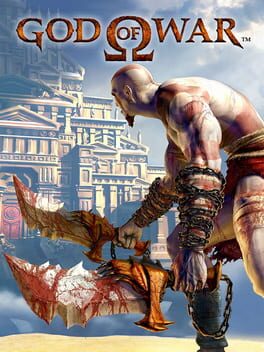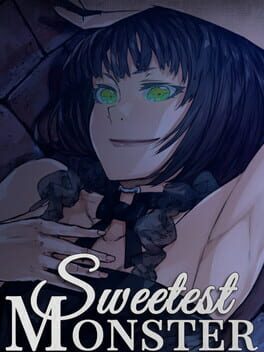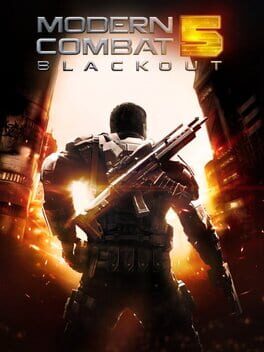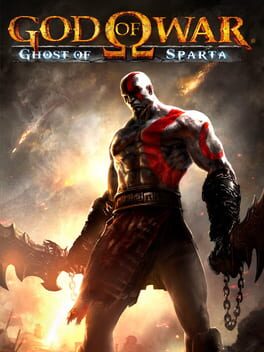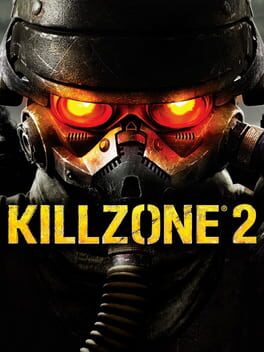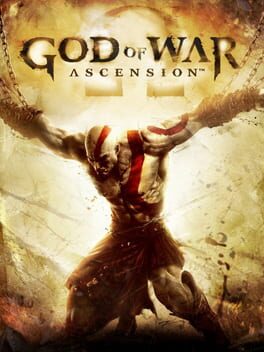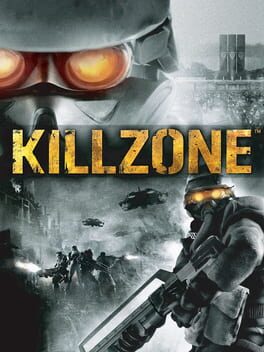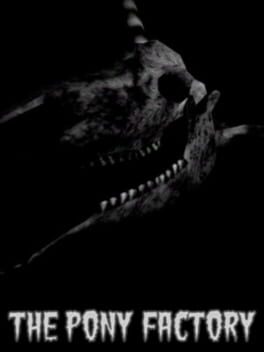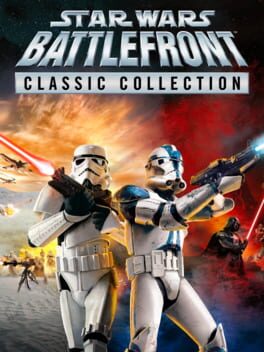Sar4h
2009
Everyone always complains about Kratos being this super angry dude, but after suffering through hours of finger destroying QTEs, annoying platforming sections, and enraging puzzles featuring way too many movable boxes, I kinda understand where he's coming from.
The game is also a pretty poor ps3 release, with fps drops and a zoomed in aspect ratio that cuts off the top and bottom of the original 4:3 presentation.
The game is also a pretty poor ps3 release, with fps drops and a zoomed in aspect ratio that cuts off the top and bottom of the original 4:3 presentation.
1985
Firing up Super Mario Bros. for the first time in 2024 feels less like playing a game and more like looking at a museum exhibit. Every few minutes, another now iconic piece of music, scenery, or enemy will pop up to remind you of the cultural impact this game had.
Unfortunately, the gameplay didn't really grab me. Mario's moveset feels fairly restrictive compared to modern titles, and the game seemingly tries to make up for that with its extreme difficulty. Perhaps it works better on an NES controller, but playing it with joycons on a Switch made me rely on the rewind feature to make it through a lot of the stages. While games like Celeste have the decency to respawn players at the beginning of a screen, Super Mario Bros. will completely reset the player's progress after a few deaths.
All in all, I recommend at least trying the game to see why it has its place in gaming history, but I suspect only hardcore gamers will make it through it without relying on save states or cheats.
Unfortunately, the gameplay didn't really grab me. Mario's moveset feels fairly restrictive compared to modern titles, and the game seemingly tries to make up for that with its extreme difficulty. Perhaps it works better on an NES controller, but playing it with joycons on a Switch made me rely on the rewind feature to make it through a lot of the stages. While games like Celeste have the decency to respawn players at the beginning of a screen, Super Mario Bros. will completely reset the player's progress after a few deaths.
All in all, I recommend at least trying the game to see why it has its place in gaming history, but I suspect only hardcore gamers will make it through it without relying on save states or cheats.
2017
Sweetest Monster is probably the most disturbing game I've ever played. It's fairly light on nudity and despite what its Steam store page says, there's also not a lot of actual "fan service" here. It's more of a deconstruction of Visual Novel tropes, but it's also very much concerned with the way men often view women. Because of that, what might be considered fan service in other VNs just made me really uncomfortable here, and I'm fairly certain that's precisely what the author intended.
It's a fairly short game (2-3 hours depending on how fast you read) and I believe that discussions of the plot would only stray into spoiler territory, something a lot of other reviews here and on Steam seem to do. It's a compelling story that quickly pulled me in and it's best experienced blind, although I recommend to perhaps check trigger warnings since this game certainly requires a lot of them. There are no decisions to make in this one, but I didn't miss them at all and think the game is better off without them.
If I had to criticize anything, it'd be that some of the characters sound a bit unnatural when talking. I especially noticed this with the protagonist's wife, whose dialogue is just to sophisticated to pass as everyday speech. This gets noticeably better after the first 10-15 minutes, so I'm not deducting to much from the score. Overall, I'd definitely recommend this for fans of darker and more mature Visual Novels.
Edit: In the days following this review I have also completed the game's sequel, Sweetest Monster Refrain. Refrain is probably the most niche game I've ever played, with not a single walkthrough on YouTube, no discussions on it anywhere, and not even a page on backloggd (which is why I'm writing about it here).
Refrain starts out almost painfully slow, but picks up after the first third. From there on the game gets better and better, building up to a single brutal decision. Due to the initial slow pacing I'd rate it around 4 stars, so slightly lower than the first one. Nevertheless, everyone who liked Sweetest Monster (and can stomach more of the game's heavy subjects) should check out Refrain.
It's a fairly short game (2-3 hours depending on how fast you read) and I believe that discussions of the plot would only stray into spoiler territory, something a lot of other reviews here and on Steam seem to do. It's a compelling story that quickly pulled me in and it's best experienced blind, although I recommend to perhaps check trigger warnings since this game certainly requires a lot of them. There are no decisions to make in this one, but I didn't miss them at all and think the game is better off without them.
If I had to criticize anything, it'd be that some of the characters sound a bit unnatural when talking. I especially noticed this with the protagonist's wife, whose dialogue is just to sophisticated to pass as everyday speech. This gets noticeably better after the first 10-15 minutes, so I'm not deducting to much from the score. Overall, I'd definitely recommend this for fans of darker and more mature Visual Novels.
Edit: In the days following this review I have also completed the game's sequel, Sweetest Monster Refrain. Refrain is probably the most niche game I've ever played, with not a single walkthrough on YouTube, no discussions on it anywhere, and not even a page on backloggd (which is why I'm writing about it here).
Refrain starts out almost painfully slow, but picks up after the first third. From there on the game gets better and better, building up to a single brutal decision. Due to the initial slow pacing I'd rate it around 4 stars, so slightly lower than the first one. Nevertheless, everyone who liked Sweetest Monster (and can stomach more of the game's heavy subjects) should check out Refrain.
Look, I know what you're about to say: "Sarah, why would you play the switch port of a mediocre 10 year old mobile fps?" To be perfectly honest, I have a weak spot for bad fps campaigns; the kind of singleplayer that tries to copy Call of Duty and horrendously fails at it, creating a product so bad it starts to become entertaining again.
Modern Combat 5 is one of those games. It's sort of like a SpaceX rocket: you hope for the best, but you also know it's going to crash and burn. Modern Combat 5 includes every single fps cliché that the ps360 generation has produced: stupid AI, a nonsensical plot about stopping terrorists (that heavily borrows from Modern Warfare 2), and of course slow motion door breaches. All of this is accompanied by generic side characters and even more generic guns. There's also a multiplayer mode that resembles a more janky version of Modern Warfare's multiplayer, although I'm fairly certain that even in 2007 Call of Duty had more than two modes.
While I was generally entertained by the utter stupidity of the game's mission design and story, the technically aspects made finishing the game a chore. The Switch port has removed the pay2win mechanics, which doesn't make the game better, it just makes it less predatory. The frame rate is simply unacceptable for a console that can run the modern Doom games, and the game is filled with bugs. Even worse, the games difficulty curve looks less like a curve, and more like what a seismograph would produce during an earthquake.
I bought this game for 2€, hoping for a bad but entertaining game. While I did have some fun, due to the games technical issues, I unfortunately can't recommend this one to even the most hardcore fans of bad games.
Modern Combat 5 is one of those games. It's sort of like a SpaceX rocket: you hope for the best, but you also know it's going to crash and burn. Modern Combat 5 includes every single fps cliché that the ps360 generation has produced: stupid AI, a nonsensical plot about stopping terrorists (that heavily borrows from Modern Warfare 2), and of course slow motion door breaches. All of this is accompanied by generic side characters and even more generic guns. There's also a multiplayer mode that resembles a more janky version of Modern Warfare's multiplayer, although I'm fairly certain that even in 2007 Call of Duty had more than two modes.
While I was generally entertained by the utter stupidity of the game's mission design and story, the technically aspects made finishing the game a chore. The Switch port has removed the pay2win mechanics, which doesn't make the game better, it just makes it less predatory. The frame rate is simply unacceptable for a console that can run the modern Doom games, and the game is filled with bugs. Even worse, the games difficulty curve looks less like a curve, and more like what a seismograph would produce during an earthquake.
I bought this game for 2€, hoping for a bad but entertaining game. While I did have some fun, due to the games technical issues, I unfortunately can't recommend this one to even the most hardcore fans of bad games.
While the combat is not quite as varied as in God of War 3, Ghost of Sparta easily makes up for this with its story. It's surprising to see a PSP spin-off dive deeper into Kratos' character than the mainline games ever did. It's great to see Kratos in a non hostile environment for once (if only for a couple of minutes), and one can even spot a lot of elements that would become much more prominent in the later PS4 era titles.
What holds the game somewhat back is the way it treats its antagonists. Whereas Zeus and Ares both get entire games worth of build up, the main antagonist in Ghost of Sparta appears only a couple minutes before the climactic boss fight against him starts. I don't think the middle part of Ghost of Sparta drags as much as the one in GoW 2 did, but I still think it could've been put to better use to flesh out Kratos' opponents.
The PS3 port is also fairly mediocre. I'm assuming that it runs better than on the PSP, but there's still tons of screen tearing, stuttering, and the game even crashed once (this might be due to my disc copy as the game froze up right when a cutscene was supposed to start). The controls also fail to make use of all the buttons available, as more than one action is bound onto single buttons - a layout that might have made sense on a PSP, but feels clunky on the PS3.
Technical issues aside, this is one of the better Greek God of War games and definitely worth playing. Despite being released after God of War 3, try to play it before playing 2 and 3, otherwise some of the dialogue in 3 won't make sense to you.
What holds the game somewhat back is the way it treats its antagonists. Whereas Zeus and Ares both get entire games worth of build up, the main antagonist in Ghost of Sparta appears only a couple minutes before the climactic boss fight against him starts. I don't think the middle part of Ghost of Sparta drags as much as the one in GoW 2 did, but I still think it could've been put to better use to flesh out Kratos' opponents.
The PS3 port is also fairly mediocre. I'm assuming that it runs better than on the PSP, but there's still tons of screen tearing, stuttering, and the game even crashed once (this might be due to my disc copy as the game froze up right when a cutscene was supposed to start). The controls also fail to make use of all the buttons available, as more than one action is bound onto single buttons - a layout that might have made sense on a PSP, but feels clunky on the PS3.
Technical issues aside, this is one of the better Greek God of War games and definitely worth playing. Despite being released after God of War 3, try to play it before playing 2 and 3, otherwise some of the dialogue in 3 won't make sense to you.
2009
Some late 2000s shooter tropes aside, Killzone 2 is still an incredibly impressive game, especially considering it released on the ps3. Enemies aggressively advance, cover shatters under fire, enemies physically interact with the environment when shot, all while lightning and weapon fire light up the scene and futuristic vehicles move around the battlefield. However, those impressive visual qualities come at a cost: the framerate frequently dips into the low to mid 20s and the input lag is fairly noticeable. Beautiful graphics aside, the gameplay is never as fun as it could be due to this sluggish overall feel.
Look, maybe I'm rating this higher than it actually desevers, but I never understood the mixed reception Ascension received when it launched.
This is one of the best looking PS3 games, the scale of the setpieces is just unbelievable. You thought the big snake in the new God of War was cool? You get a new setpiece of equal scale every other hour. Ascension rivals and arguably surpasses even the Poseidon fight at the beginning of God of War 3 when it comes to pure eye candy. You sometimes even lose sight of Kratos because the camera has to zoom out so far to capture all of the action.
Granted, the frame rate suffers in some scenes, but the 60 fps framerate target means that game stays playable even during dips. Experiences may differ, but I never felt like I missed an input because of low fps.
The combat system has been reworked and while I think the one in 3 is still slightly better, I like Ascension's new mechanics too. Making more use of the chains and the ability to pick up several secondary weapons are good additions, and I also like the different infusions Kratos' blades gain. Each of the four is themed after a god and offers a slightly changed moveset. They aren't as specialized as I would've wanted them to be, but what's there is still great fun.
Many of the other common points of criticism are either nonsensical or also apply to the other God of War games. Pacing issues? Every God of War pre 3 is worse. Tacked on multiplayer? Noone forces you to play it and the game is still as long and polished as the other entries.
I do agree that the story isn't adding too much to the overarching plot, but it works well enough. Kratos even gets to show emotions and is able to peacefully interact with another man! It's clear that they tried to do something about the series' sexism and while Ascension still sexualizes women, it's far less cringe worthy than the prior games with their sex QTEs.
All in all, Ascension is a great action game filled with awesome setpieces and deserves to stand next to the mainline titles. I'd rather replay this over the first two games or Chains of Olympus any day, and I recommend anyone who owns a PS3 and enjoys character action games at least gives it a try.
This is one of the best looking PS3 games, the scale of the setpieces is just unbelievable. You thought the big snake in the new God of War was cool? You get a new setpiece of equal scale every other hour. Ascension rivals and arguably surpasses even the Poseidon fight at the beginning of God of War 3 when it comes to pure eye candy. You sometimes even lose sight of Kratos because the camera has to zoom out so far to capture all of the action.
Granted, the frame rate suffers in some scenes, but the 60 fps framerate target means that game stays playable even during dips. Experiences may differ, but I never felt like I missed an input because of low fps.
The combat system has been reworked and while I think the one in 3 is still slightly better, I like Ascension's new mechanics too. Making more use of the chains and the ability to pick up several secondary weapons are good additions, and I also like the different infusions Kratos' blades gain. Each of the four is themed after a god and offers a slightly changed moveset. They aren't as specialized as I would've wanted them to be, but what's there is still great fun.
Many of the other common points of criticism are either nonsensical or also apply to the other God of War games. Pacing issues? Every God of War pre 3 is worse. Tacked on multiplayer? Noone forces you to play it and the game is still as long and polished as the other entries.
I do agree that the story isn't adding too much to the overarching plot, but it works well enough. Kratos even gets to show emotions and is able to peacefully interact with another man! It's clear that they tried to do something about the series' sexism and while Ascension still sexualizes women, it's far less cringe worthy than the prior games with their sex QTEs.
All in all, Ascension is a great action game filled with awesome setpieces and deserves to stand next to the mainline titles. I'd rather replay this over the first two games or Chains of Olympus any day, and I recommend anyone who owns a PS3 and enjoys character action games at least gives it a try.
2011
Killzone 2's graphics had already pushed the PS3 to its limit, and while the result was impressive, the game had horrible input lag and a framerate that often dropped into the low 20s. When it came to developing Killzone 3, it seems like Guerilla Games prioritized performance and latency; if you know where to look, you'll quickly notice that some effects were visibly reduced. Concrete no longer dynamically crumbles under fire, and muzzle flash shadows are similarly pared back, to name two examples.
That's not to say that Killzone 3 looks bad, the opposite is the case. In some areas, like the sheer amount of environmental destruction, Killzone 3 might even be superior to some modern shooters. Most players won't even notice the reduced effects in the heat of battle, and the shift in technical resources lead to a significantly improved shooting experience. Thanks to the reworked controls, new aim assist, and absence of input lag, the combat feels better than ever. It might not be the Halo killer that Sony had hoped for, but it's still an excellent combat loop.
Killzone 3's campaign is fairly short, but makes up for it with the sheer number of unique setpieces and levels. Missions see players sneak through a jungle filled with strange alien plants, drive several vehicles, and even use a jetpack to fight in the air above arctic offshore rigs - and that's just part of what happens in the game's first half. The campaign feels like a playable sci-fi action movie, and I mean that in the best way possible.
While the gameplay is fun and diverse, Killzone 3 unfortunately falls short as the conclusion to the Killzone trilogy. All the Killzone games are fairly different in terms of writing, style, and overall themes. Killzone 3 doesn't feel like a natural follow-up to the second game, especially considering how the game immediately introduces two very important Helghast commanders that were never mentioned before, even though one of them is apparently responsible for basically every advanced piece of weaponry the Helghast use. The game ends with another cliffhanger, similarly to Killzone 2. The difference is that while the ending of Killzone 2 was built up throughout the game and felt like a subversion of shooter tropes, the cliffhanger in 3 felt like the second half of the ending cutscene was just missing. I guess what I'm trying to say is, don't play this one for the story.
That's not to say that Killzone 3 looks bad, the opposite is the case. In some areas, like the sheer amount of environmental destruction, Killzone 3 might even be superior to some modern shooters. Most players won't even notice the reduced effects in the heat of battle, and the shift in technical resources lead to a significantly improved shooting experience. Thanks to the reworked controls, new aim assist, and absence of input lag, the combat feels better than ever. It might not be the Halo killer that Sony had hoped for, but it's still an excellent combat loop.
Killzone 3's campaign is fairly short, but makes up for it with the sheer number of unique setpieces and levels. Missions see players sneak through a jungle filled with strange alien plants, drive several vehicles, and even use a jetpack to fight in the air above arctic offshore rigs - and that's just part of what happens in the game's first half. The campaign feels like a playable sci-fi action movie, and I mean that in the best way possible.
While the gameplay is fun and diverse, Killzone 3 unfortunately falls short as the conclusion to the Killzone trilogy. All the Killzone games are fairly different in terms of writing, style, and overall themes. Killzone 3 doesn't feel like a natural follow-up to the second game, especially considering how the game immediately introduces two very important Helghast commanders that were never mentioned before, even though one of them is apparently responsible for basically every advanced piece of weaponry the Helghast use. The game ends with another cliffhanger, similarly to Killzone 2. The difference is that while the ending of Killzone 2 was built up throughout the game and felt like a subversion of shooter tropes, the cliffhanger in 3 felt like the second half of the ending cutscene was just missing. I guess what I'm trying to say is, don't play this one for the story.
2015
1988
The first actual sequel to Super Mario Bros. is a bigger and more creative game. Every new world brings new gameplay mechanics with it and while boss fights are still repeated quite often, at least there's more than one now.
However, I'm not a big fan of the game's difficulty. How hard a game is is of course subjective and some players might enjoy the challenge, but some levels almost require memorization. The issue is that with the side scrolling perspective, enemies and traps often pop up too late to realistically react to, making some deaths feel very cheap. This can be somewhat mitigated on modern emulators with save states or rewinds.
I also have some complaints about the NES emulator included with the Nintendo Online subscription. I know that the quality of an emulator isn't the games fault, but as this is a paid service offered by the same company that published the game in the first place, I'm making an exception. The NES emulator heavily distorts the right border of the image, showing blocks that just enter the screen in the wrong color. This can affect gameplay as it makes reacting to dangers harder, and it's also just kind of embarrassing - the game deserves better.
If you have the chance to play this game on original hardware or on another emulator, you can easily add an additional star to my rating. Overall, it's an enjoyable game, but only for those willing to deal with it's brutal difficulty.
However, I'm not a big fan of the game's difficulty. How hard a game is is of course subjective and some players might enjoy the challenge, but some levels almost require memorization. The issue is that with the side scrolling perspective, enemies and traps often pop up too late to realistically react to, making some deaths feel very cheap. This can be somewhat mitigated on modern emulators with save states or rewinds.
I also have some complaints about the NES emulator included with the Nintendo Online subscription. I know that the quality of an emulator isn't the games fault, but as this is a paid service offered by the same company that published the game in the first place, I'm making an exception. The NES emulator heavily distorts the right border of the image, showing blocks that just enter the screen in the wrong color. This can affect gameplay as it makes reacting to dangers harder, and it's also just kind of embarrassing - the game deserves better.
If you have the chance to play this game on original hardware or on another emulator, you can easily add an additional star to my rating. Overall, it's an enjoyable game, but only for those willing to deal with it's brutal difficulty.
2012
Pretty bad remaster that does little to fix the flaws of the PS2 original. There's an increase in resolution but the game still runs at 30 fps with textures that are embarrassing for a 2012 release.
The game also has some pretty clunky and unresponsive controls which, combined with the often subpar level design, can make it a chore to play through. However, the story and world building are fairly interesting, making the cutscenes enjoyable to watch. The game's score is also great but doesn't play during regular gameplay for some reason.
Ultimately a flawed release but worth it for those who want to see where the series came from.
The game also has some pretty clunky and unresponsive controls which, combined with the often subpar level design, can make it a chore to play through. However, the story and world building are fairly interesting, making the cutscenes enjoyable to watch. The game's score is also great but doesn't play during regular gameplay for some reason.
Ultimately a flawed release but worth it for those who want to see where the series came from.
2024
I've been following David Szymanski's work since Dusk, and have since bought pretty much all of his games on or around release day. Looking at his work, it quickly becomes apparent that he has a knack for both horror and shooter design. The Pony Factory leans more into the horror side, although it still includes fps elements.
Pony Factory feels like a love letter to Doom 3. Back when Doom 3 first released, players could not equip a weapon and a flashlight at the same time, meaning they had to choose between being able to see or being able to shoot. The BFG re-release would eventually change that, but Szymanski seemingly enjoyed this dynamic so much that he made it the core mechanic of Pony Factory. The game's sharp shadows and heavily stylized lighting lend themselves well to this sort of gameplay, and some of the scares definitely caught me off guard.
However, it's important to remember that Pony Factory is not a big release. This is a 4€ game that regularly goes on sale and can be completed in less than an hour. There are some alternative gameplay modes, but nothing to keep players hooked for hours on end. The game reusing some of its levels has been criticized but I personally didn't mind it, especially since making a level that works well no matter from what direction you approach it is incredibly impressive. Ultimately, Pony Factory is a very good bite sized horror fps, and a must play for every fan of Doom 3.
Pony Factory feels like a love letter to Doom 3. Back when Doom 3 first released, players could not equip a weapon and a flashlight at the same time, meaning they had to choose between being able to see or being able to shoot. The BFG re-release would eventually change that, but Szymanski seemingly enjoyed this dynamic so much that he made it the core mechanic of Pony Factory. The game's sharp shadows and heavily stylized lighting lend themselves well to this sort of gameplay, and some of the scares definitely caught me off guard.
However, it's important to remember that Pony Factory is not a big release. This is a 4€ game that regularly goes on sale and can be completed in less than an hour. There are some alternative gameplay modes, but nothing to keep players hooked for hours on end. The game reusing some of its levels has been criticized but I personally didn't mind it, especially since making a level that works well no matter from what direction you approach it is incredibly impressive. Ultimately, Pony Factory is a very good bite sized horror fps, and a must play for every fan of Doom 3.
Metroid Prime Remastered is a perfect remaster of a very flawed game. It's one of the best looking games on the Switch, with gorgeous environmental design and beautifully reworked lighting and effects. The low texture resolution is pretty much the only complaint to make at this point, and it's a very minor one. Overall image quality is sharp and the game runs without any fps drops. Compared to the original, Prime now has a 16:9 widescreen resolution and a variety of reworked control option. I chose the default control scheme with gyro aiming and had a serviceable experience, although swapping between beams (essentially the different weapons in Prime) felt somewhat clunky and unresponsive at times.
I mentioned above that I consider this to be a flawed game, but that doesn't mean that it's a bad experience. There's much to enjoy here, and it's unfortunate that Metroid Prime never became as genre defining as the 2D Metroids were. Excluding the other Prime games, there are simply no shooters like this. Metroid Prime values exploration and atmosphere over combat and quick reflexes. You can go through entire areas without encountering the default humanoid shooty enemies that are the standard throughout the shooter genre. When you eventually end up in a confrontation with either the local wildlife or space pirates, positioning and choice of beam type are always more important than the act of aiming.
The moment I felt the game was truly special was when I unlocked a new weapon and, instead of contemplating its effectiveness against enemies, I thought about all the areas I could now access. As cliché as it might sound, the game truly makes you feel like it's you alone, tasked with exploring this alien planet with its ruined civilization.
Unfortunately, the game does have a few issues. On the one hand, I think the developers choosing not to implement too many quality of life changes is commendable. For example, implementing fast travel would have destroyed the feeling of an interconnected world without loading screens. On the other hand, I'd hoped for at least some kind of autosave. Some might argue that autosaves would hurt the game's intended difficulty, but I think a one time continue point similar to the Dark Souls save system would've worked well here. The Switch is a portable console, and losing up to 30 minutes because you had to stop your play session or decided to play something else can be frustrating.
Even worse are the games final 2-3 hours. Space pirates and Metroids become the primary enemy type to fight, and neither are especially fun to face off against. Players will also encounter more and more platforming segments, which aren't the games strongest mechanic either. And then, just when you're about ready to face the final bosses with all your upgrades, you need to backtrack through all the game's areas to collect 12 artefacts, grinding the games pacing to a screeching halt. At this point, a lot of players will feel compelled to pick up a guide, which isn't exactly great for a game focused on exploration.
My frustration culminated in a room right before the final boss. The room consisted of a platforming section players had to traverse whilst being attacked by flying enemies. If you miss a platform, you fall down and have to start over again. If you collide with one of the flying enemies, you most likely fall down and have to start over again. If one of the enemies latches onto you, your screen gets distorted, you most likely miss your platform, fall down, and have to start over again. Now for the real fun part: even if you somehow manage to not fall down when an enemy latches on to you, the only way to get rid of them is to turn into a ball and detonate a bomb (it makes more sense in context, bear with me). However, detonating said bomb does not only get rid of the enemy, it will also catapult you in the air, and can easily make you roll of the platform once you fall down, leading to you having to restart all over again.
I know, this sounds like complaining for the sake of complaining, but I just had less and less fun the longer I played, and those last 2-3 hours were the one point pretty much everyone criticized the original game for. Before those, I had considered the game to be essentially perfect, and I'm somewhat sad that I can't fully recommend Prime Remastered because of it. That being said, I still believe that every fan of the fps genre should at least try the game for themselves, if only to see what the genre is truly capable of.
I mentioned above that I consider this to be a flawed game, but that doesn't mean that it's a bad experience. There's much to enjoy here, and it's unfortunate that Metroid Prime never became as genre defining as the 2D Metroids were. Excluding the other Prime games, there are simply no shooters like this. Metroid Prime values exploration and atmosphere over combat and quick reflexes. You can go through entire areas without encountering the default humanoid shooty enemies that are the standard throughout the shooter genre. When you eventually end up in a confrontation with either the local wildlife or space pirates, positioning and choice of beam type are always more important than the act of aiming.
The moment I felt the game was truly special was when I unlocked a new weapon and, instead of contemplating its effectiveness against enemies, I thought about all the areas I could now access. As cliché as it might sound, the game truly makes you feel like it's you alone, tasked with exploring this alien planet with its ruined civilization.
Unfortunately, the game does have a few issues. On the one hand, I think the developers choosing not to implement too many quality of life changes is commendable. For example, implementing fast travel would have destroyed the feeling of an interconnected world without loading screens. On the other hand, I'd hoped for at least some kind of autosave. Some might argue that autosaves would hurt the game's intended difficulty, but I think a one time continue point similar to the Dark Souls save system would've worked well here. The Switch is a portable console, and losing up to 30 minutes because you had to stop your play session or decided to play something else can be frustrating.
Even worse are the games final 2-3 hours. Space pirates and Metroids become the primary enemy type to fight, and neither are especially fun to face off against. Players will also encounter more and more platforming segments, which aren't the games strongest mechanic either. And then, just when you're about ready to face the final bosses with all your upgrades, you need to backtrack through all the game's areas to collect 12 artefacts, grinding the games pacing to a screeching halt. At this point, a lot of players will feel compelled to pick up a guide, which isn't exactly great for a game focused on exploration.
My frustration culminated in a room right before the final boss. The room consisted of a platforming section players had to traverse whilst being attacked by flying enemies. If you miss a platform, you fall down and have to start over again. If you collide with one of the flying enemies, you most likely fall down and have to start over again. If one of the enemies latches onto you, your screen gets distorted, you most likely miss your platform, fall down, and have to start over again. Now for the real fun part: even if you somehow manage to not fall down when an enemy latches on to you, the only way to get rid of them is to turn into a ball and detonate a bomb (it makes more sense in context, bear with me). However, detonating said bomb does not only get rid of the enemy, it will also catapult you in the air, and can easily make you roll of the platform once you fall down, leading to you having to restart all over again.
I know, this sounds like complaining for the sake of complaining, but I just had less and less fun the longer I played, and those last 2-3 hours were the one point pretty much everyone criticized the original game for. Before those, I had considered the game to be essentially perfect, and I'm somewhat sad that I can't fully recommend Prime Remastered because of it. That being said, I still believe that every fan of the fps genre should at least try the game for themselves, if only to see what the genre is truly capable of.
A terrible release all around. The core gameplay is still fun, but that's due to the work Pandemic did 20+ years ago. All Aspyr did was AI upscale the textures, add a few reflections to surfaces, and port former Xbox exclusive content to PC. Unfortunately, they screwed up nearly all of this. Thanks to the new textures, the game now requires 60 GB of storage space - that's 10 GB more than the 2015 Battlefront with all DLCs requires! Additionally, the new reflections look weirldy out of place in most locations.
Battlefront 2 now uses the menus of the console versions which look better, but also cut some of the more advanced functions of the original PC version. Multiplayer is straight up awful, even before you get to the gameplay part. The quick match functionality tries to connect you to password protected servers, meanwhile the server browser tended to not load at all for me most of the time.
There are bugs and issues no matter where you look - keep in mind I found everything I list here in less than an hour of playtime. Certain guns clip through the screen, cutscenes show heavy artifacting, even the movie clips that loop in the menu backgrounds are compressed to hell and back. Oh, and sometimes the game will just produce an ear shattering audio error sound - hope you're not playing with headphones!
I have seen this called a cashgrab and I disagree, because a cashgrab would actually make Aspyr money. I have refunded my copy, and I'm assuming others will do the same. As of right now, I see no point in playing this over the originals. Both are available on PC with functioning multiplayer support and tons of mods. In a year or so, this Collection might be patched to a point where it's worth buying, but considering the blatent lack of competence Aspyr has displayed time and time again, I wouldn't bet on it.
Battlefront 2 now uses the menus of the console versions which look better, but also cut some of the more advanced functions of the original PC version. Multiplayer is straight up awful, even before you get to the gameplay part. The quick match functionality tries to connect you to password protected servers, meanwhile the server browser tended to not load at all for me most of the time.
There are bugs and issues no matter where you look - keep in mind I found everything I list here in less than an hour of playtime. Certain guns clip through the screen, cutscenes show heavy artifacting, even the movie clips that loop in the menu backgrounds are compressed to hell and back. Oh, and sometimes the game will just produce an ear shattering audio error sound - hope you're not playing with headphones!
I have seen this called a cashgrab and I disagree, because a cashgrab would actually make Aspyr money. I have refunded my copy, and I'm assuming others will do the same. As of right now, I see no point in playing this over the originals. Both are available on PC with functioning multiplayer support and tons of mods. In a year or so, this Collection might be patched to a point where it's worth buying, but considering the blatent lack of competence Aspyr has displayed time and time again, I wouldn't bet on it.
Considering all the games in the New Super Mario Bros. series we have today, Nintendo going 14 years without releasing a traditional 2D Mario game seems almost hard to believe. New Super Mario Bros. successfully introduces a 2.5D look to the series and despite the DS's relatively weak hardware, this style works surprisingly well. The game makes excellent use of color, leading to an easily readable game, even at the low resolution it shipped with.
NSMB manages to introduce new gameplay elements throughout the entire game, up to and including the final world. A lot of those are reused from earlier Mario titles, but that doesn't make them any less fun. Even 18 years after its release, the platforming holds up surprisingly well.
While I can only praise the core gameplay loop, I do have some minor points of criticism: Firstly, the game's difficulty is all over the place - during some worlds I was showered with extra lives, only to lose them all in the final world. In fact, it got so bad I even had to go back to earlier worlds to grind additional lives. The tiny controls of the DS line of hardware certainly don't help with the precise platforming the game often requires, making me wish for a re-release on modern platforms.
All of my criticisms might sound like nitpicking, but that only speaks for the overall quality of NSMB. Even though I struggled with the final levels, I got so captivated that I stayed awake until 4 am so I could finally finish the game. All things considered, I wouldn't call the first NSMB a must play, mainly because of its sequels existing on newer consoles. That doesn't change the fact that NSMB is one of, if not the best platformer on the original DS.
NSMB manages to introduce new gameplay elements throughout the entire game, up to and including the final world. A lot of those are reused from earlier Mario titles, but that doesn't make them any less fun. Even 18 years after its release, the platforming holds up surprisingly well.
While I can only praise the core gameplay loop, I do have some minor points of criticism: Firstly, the game's difficulty is all over the place - during some worlds I was showered with extra lives, only to lose them all in the final world. In fact, it got so bad I even had to go back to earlier worlds to grind additional lives. The tiny controls of the DS line of hardware certainly don't help with the precise platforming the game often requires, making me wish for a re-release on modern platforms.
All of my criticisms might sound like nitpicking, but that only speaks for the overall quality of NSMB. Even though I struggled with the final levels, I got so captivated that I stayed awake until 4 am so I could finally finish the game. All things considered, I wouldn't call the first NSMB a must play, mainly because of its sequels existing on newer consoles. That doesn't change the fact that NSMB is one of, if not the best platformer on the original DS.
